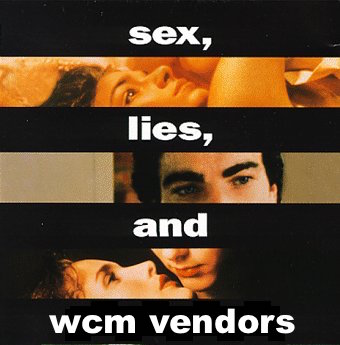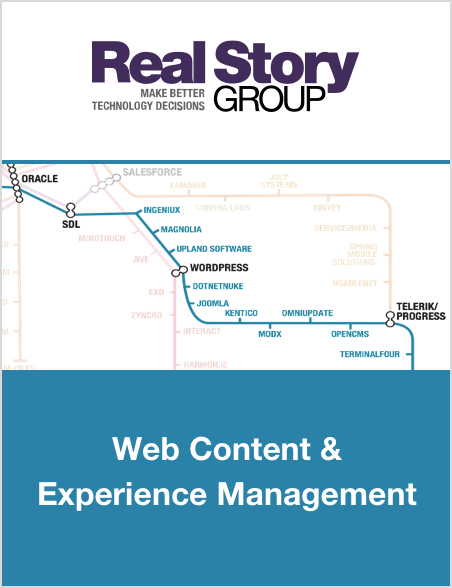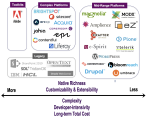Sex, Lies, and WCM Vendors
Over the past two decades, Web Content & Experience Management (WCM) technology has become more complex and therefore more of a "solution sale." Most WCM vendor sales reps have become good educators, but they also have quotas to meet. So, vendors will sometimes short-cut important discussions about functionality and pricing with simple — but not always totally truthful — answers.
So here's a list of 10 common myths you might hear during the sales process. As my grandmother used to say, forewarned is forearmed.
Ten Myths
1) "We'll handle all your digital marketing & engagement" (This is the sex part)
Many if not most WCM vendors have recast themselves as "digital experience platforms." What that actually means will vary from provider to provider, but a common thread is that the vendor wants to supply a wide range of digital engagement services, including mobile, social, email, video, ecommerce, and more. From their standpoint it makes sense: they want a bigger footprint in your environment ("greater share of your wallet," they'll tell investors), and they can often show fancy dashboards and unified metrics that look positively dreamy to the harried digital marketer trying to thread together different systems.
But here's the downside: the non-WCM services in their toolkits are likely to be much less effective than the systems you employ for outbound marketing and analytics now. And you'll discover that the sexy integration modeled in the demo is actually pretty patchy in real life. Customer digital engagement is going to be a multi-supplier endeavor for most enterprises; we all just have to get good at integration and data analytics.
2) "Our interface will sell itself" (This is also sexy)
WCM salespeople endemically overestimate the usability of their product interfaces. You too might get excited by snazzy contribution wizards and sexy widget configuration screens — only to have real marketers and editors exclaim, "what the hell is that?"
Remember: what's easy for one contributor or marketer can be difficult for the next. Know your editorial and management personas and be sure to build and test their journeys along with those of your customers.

3) "You only need XY thousand to get started"
Salespeople everywhere try to lure prospects with low entry-level pricetags, and WCM sales reps are no different. The most common set of sandbagging tactics we see at RSG:
- Specifying an initial configuration that's too thin for you even out of the gate
- Neglecting to quote dev/test/stage environments
- Neglecting to quote optional modules that were demo'ed or tested as part of the solution
- Opening with a "bronze-level" support or cloud arrangement that's less than adequate for your size
Always make sure to have a broad internal team poke at price proposals to ensure pricing aligns with your expectations — and what you really need.
4) "Don't worry: everything's in the cloud"
Enterprise WCM customers have switched dramatically to cloud-based deployments, and vendors (to their credit) have responded quickly, often with variable options, like deploying in your incumbent IaaS provider, their single-tenant PaaS environment, or their multi-tenant SaaS offering. So far, so good.
But cloud doesn't absolve you of responsibility for the health and effectiveness of the overall system. First of all, cloud environments do sometimes fail — though with less likelihood than your own datacenter. More generally, in return for relieving some of your burdens, cloud environments can put new restrictions on you: on the modules you deploy, your ability to quickly push changes into production, when you upgrade, and where and how you an integrate other enterprise systems.
Yes, you should consider cloud-first deployments, but you need to get really clear about who's responsible for what, and at what cost.
Whenever I get question or complaint from marketing client, set auto-responder to say, 'It in Cloud - all taken care of'. And they go away.
— CMS_Borat (@CMS_Borat) March 19, 2015
5) "Our open-source solution means low prices and code transparency," or
"Our commercial solution is better supported than open-source alternatives"
Two sides of the same fib. Over time, licensing fees will constitute an increasingly smaller fraction of your total cost of ownership. Your biggest expenses will lie in customization, integration, and managed cloud services. And here, some open-source tools will cost you more than their commercial equivalents.
At the same time, you'll find that support for a typical commercial CMS compares poorly against the kind of community help you can receive from from a large, global, open-source project. Key word there is large.
6) "No requirements? No problem! Our business analysts can get you quick-started"
If you haven't thought through the requirements for your new platform — ideally as narrative customer and employee journeys — you have no business expecting a successful WCM implementation. Sure, CMS vendors often carry good (sometimes very good) analysts on staff, but they tend to be oriented towards getting the solution "stood up" quickly, rather than making sure you're managing content and experiences optimally.
Also, a vendor's analyst will never tell you what could be an unpleasant but important truth: that a WCM platform itself won't solve your real problems.
7) "Most enterprises deploy our solution within 4-6 weeks" (now we're getting into some serious dishonesty)
Most enterprises deploy a full-blown WCM platform over the course of a year or more. You can indeed implement smaller projects and departmental pilots over the course of say, 3-4 months. In fact, agaile methodologies and proper product management teach us the value of breaking up large projects into bite-sized pieces, so do set milestones every 4-6 weeks. Just count on a lot of them.
8) "Our migration scripts will take care of your existing content"
Garbage in, garbage out. The best way to ease the pain of migration is to start cleaning up your content now. To be fair, I see vendors promising this less, especially when an integration partner is in the room; they've seen the pain first-hand. This is why many integrators won't even give you a quote for migration until they've completed extensive discovery. They know their scripts will take them only so far...
9) "Our product is better than Adobe and Sitecore, for a fraction of the cost"
Fact is, there are tiers in the WCM marketplace for a reason. The most complicated platforms are geared to tackle big, complex, even unique problems. Sure, many customers still overbuy WCM products, including Adobe, when they could have gotten away with something simpler and cheaper.
But small WCM vendors sometimes underestimate how hard it is to execute on content-oriented digital engagement across a large enterprise; you become their tutor at your own risk.
10) "We're the only product with..."
The WCM marketplace worldwide holds more than 1000 vendors by my estimation. Innovations get copied quickly. As Web CMS Report readers know, WCM solutions distinguish themselves less on what they offer, and more on how they work and the specific use-cases they target.
In the End
Of course, the core problem with the WCM selections is not fast-talking salespeople, but unprepared buyers. Get smart about your particular needs and the marketplace. Build the right team. Benchmark your current capacity. Then you'll be ready for whatever whoppers come your way during the sales process.
Let me know if you'd like to understand more how RSG's research and advisory services can help your team make the best WCM decisions.









